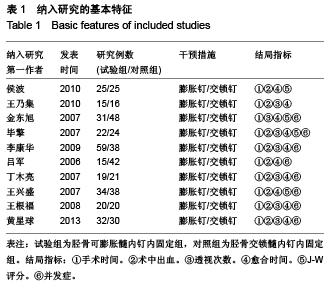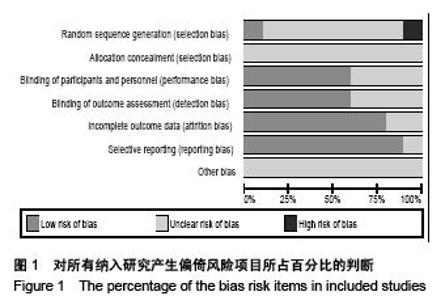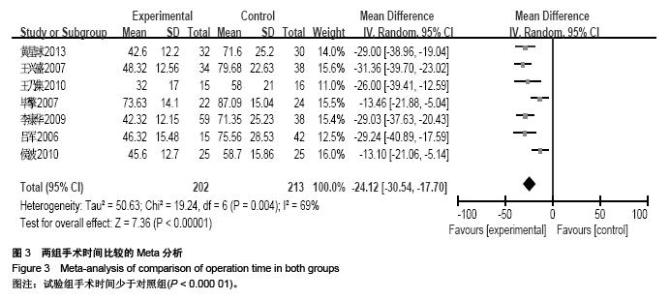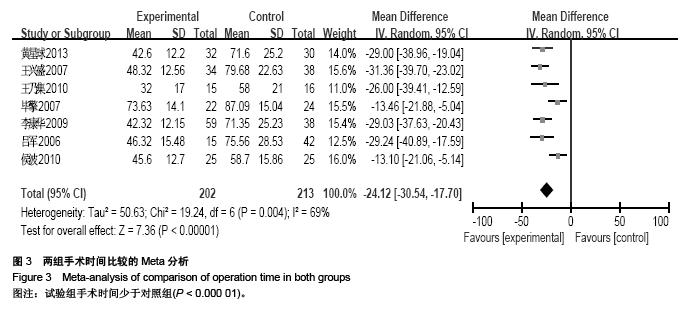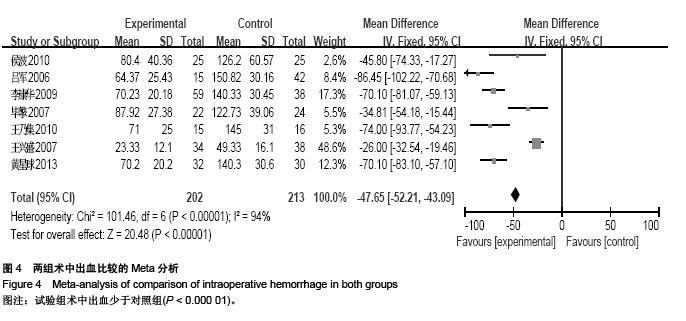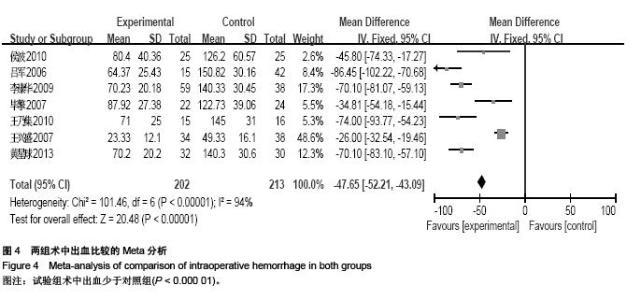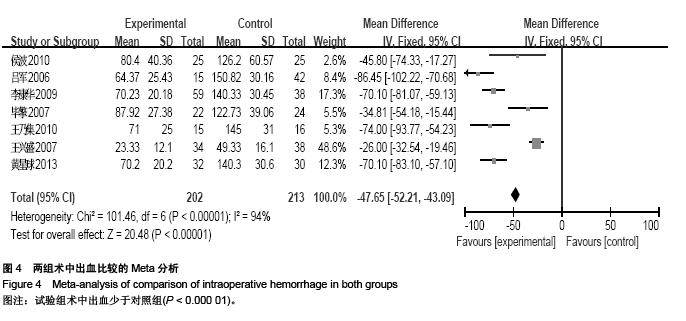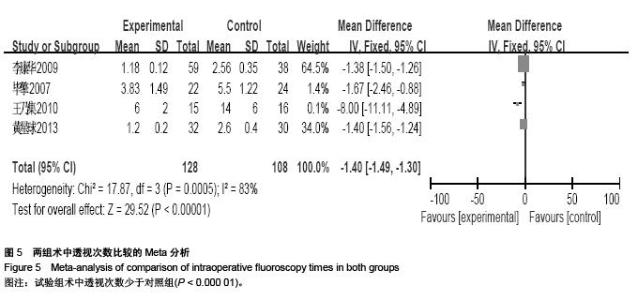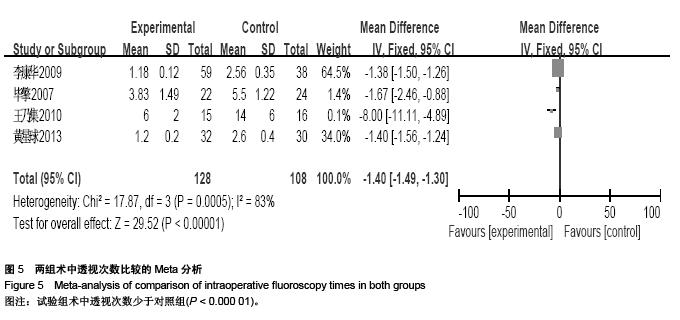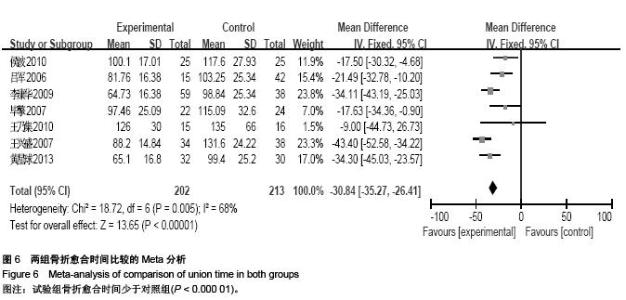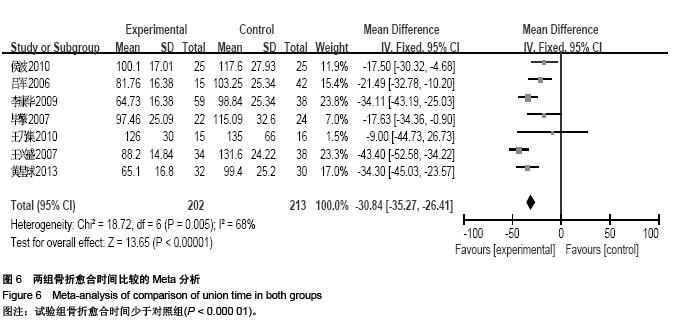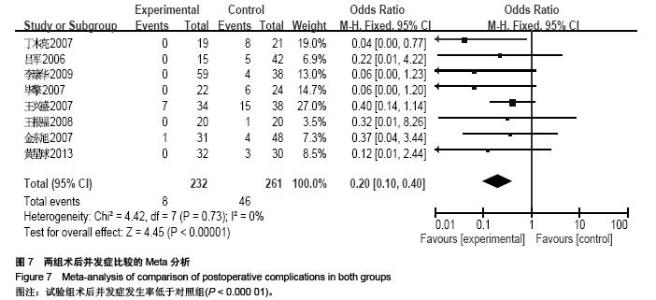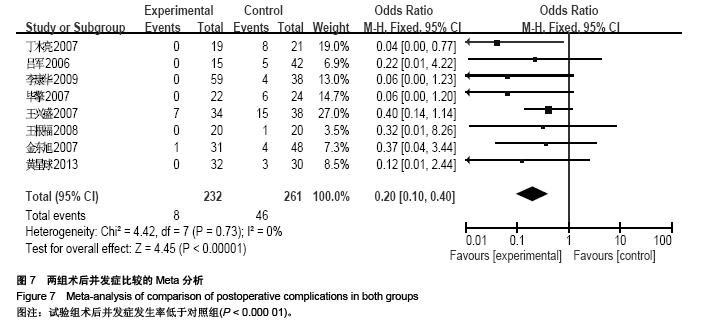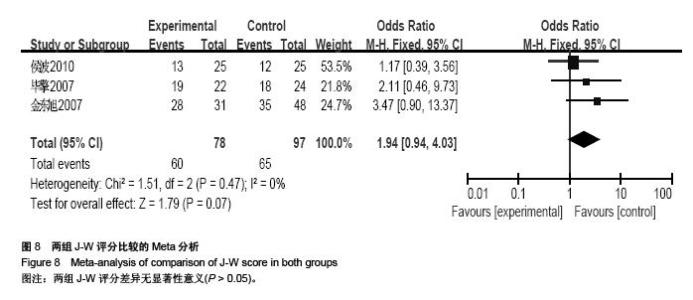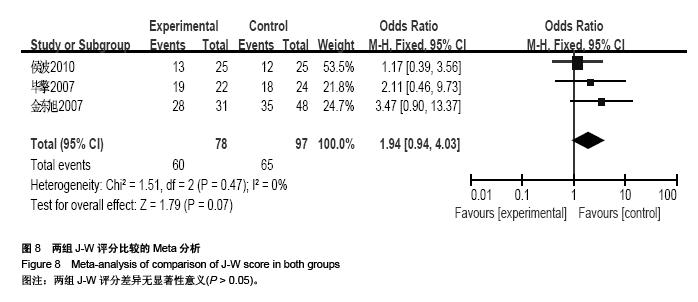Chinese Journal of Tissue Engineering Research ›› 2015, Vol. 19 ›› Issue (53): 8670-8676.doi: 10.3969/j.issn.2095-4344.2015.53.020
Previous Articles Next Articles
A meta-analysis of expandable intramedullary nail versus interlocking intramedullary nail for treatment of tibia fracture
Wang Wen-da, Jin Qi, Ruan Wen-feng, Ping An-song
- Department of Orthopedics, Zhongnan Hospital of Wuhan University, Wuhan 430071, Hubei Province, China
-
Received:2015-10-12Online:2015-12-24Published:2015-12-24 -
About author:Wang Wen-da, Studying for master’s degree, Department of Orthopedics, Zhongnan Hospital of Wuhan University, Wuhan 430071, Hubei Province, China
CLC Number:
Cite this article
Wang Wen-da, Jin Qi, Ruan Wen-feng, Ping An-song. A meta-analysis of expandable intramedullary nail versus interlocking intramedullary nail for treatment of tibia fracture[J]. Chinese Journal of Tissue Engineering Research, 2015, 19(53): 8670-8676.
share this article
| [1] Sefano L, Nicola C, Luciano L, et al. Peliminary clinical and radio-graphic results with fixion intramedullary nail: an inflatable self-locking system for long bone fractures. J Othop Traumatol. 2000: 135-140.[2] 侯波.可膨胀自锁髓内钉与交锁髓内钉治疗胫骨骨折的疗效评价[J].临床医药实践,2010,19(6): 738-739.[3] 王乃集,郑圣鼐,张大闯,等.扩张自锁髓内钉与交锁髓内钉治疗胫骨干闭合骨折的临床比较研究[J].中国骨与关节损伤杂志,2010, 25(9): 794-796.[4] 金东旭,张智长,孙玉强,等.可膨胀髓内钉与传统交锁髓内钉在胫骨干骨折中的应用对照研究[J].中国修复重建外科杂志,2007, 21(6): 629-632.[5] 毕擎,朱丹杰,邱斌松,等. Comparative study on treatment of midshaft tibial fracture with expandable and interlocking intramedullary nails[J]. 中华创伤杂志(英文版),2007,10(4): 228-232.[6] 李康华,廖瞻,梁捷予,等. Fixion膨胀髓内钉治疗胫骨干骨折的临床疗效分析[J].医学临床研究,2009, 26(10): 1792-1794.[7] 吕军,张喆,夏冰,等.可膨胀髓内钉和交锁髓内钉在胫骨干骨折治疗中的比较[J]. 浙江创伤外科,2006,11(4):285-287.[8] 丁木亮,倪江东,李欣.膨胀髓内钉与交锁髓内钉治疗胫骨干骨折的疗效比较[J]. 医学临床研究, 2007, 24(9): 1472-1475. [9] 王兴盛,练克俭,翟文亮,等.可膨胀髓内钉与带锁髓内钉治疗胫骨骨折的疗效分析[J].临床骨科杂志,2007,10(5):418-420.[10] 王根福,吕建元,陈吉,等.可膨胀自锁髓内钉与交锁髓内钉治疗胫骨骨折的疗效比较[J]. 中国骨与关节损伤杂志,2008,23(7): 580-581.[11] 黄星球.膨胀髓内钉治疗胫骨干骨折的临床观察[J].特别健康(下半月),2013,11(12): 76.[12] Lepore L, Lepore S, Maffulli N. Intramedullary nailing of the femur with an inflatable self-locking nail: comparison with locked nailing. J Orthop Sci. 2003;8(6): 796-801.[13] Whatling GM, Nokes LD. Literature review of current techniques for the insertion of distal screws into intramedullary locking nails. Injury. 2006; 37:109-119.[14] Niu Y, Bai Y, Xu S, et al. Treatment of lower extremity long bone nonunion with expandable intramedullary nailing and autologous bone grafting. Arch Orthop Trauma Surg, 2011; 131(7): p. 885-91.[15] Kapoor SK, Kataria H, Boruah T, et al. Expandable self-locking nail in the management of closed diaphyseal fractures of femur and tibia. Indian J Orthop, 2009;43(3): 264-270.[16] Jovanovic A, Pirpiris M, Semirli H, et al. Fixion nails for humeral fractures. Injury. 2004;35:1140-1142.[17] Ghafil D, Ackerman P, Baillon R, et al. Expandable intramedullary nails for fixation of tibial shaft fractures. Acta Orthop Belg. 2012;78(6): 779-785.[18] Folman Y, Ron N, Shabat S, et al. The Fixion expandable stem hemiarthroplasty for displaced femoral neck fracture: technical features and pilot study. Arch Orthop Trauma Surg. 2010;130:527-531.[19] 王强和.膨胀髓内钉治疗四肢骨折临床分析[J]. 医学信息,2013, 26(14):199-200.[20] Rose DM, Smith TO, Nielsen D, et al. Expandable intramedullary nails in lower limb trauma: a systematic review of clinical and radiological outcomes. Strategies Trauma Limb Reconstr. 2013;8(1): 1-12.[21] Steinberg EL, Keynan O, Sternheim A, et al. Treatment of diaphyseal nonunion of the femur and tibia using an expandable nailing system. Injury. 2009;40(3): 309-314.[22] Zoccali C, Di Francesco A, Ranalletta A, et al. Clinical and radiological midterm results from using the Fixion expandable intramedullary nail in transverse and short oblique fractures of femur and tibia. J Orthop Traumatol. 2008;9(3): 123-128.[23] Ben-Galim P, Rosenblatt Y, Parnes N, et al. Intramedullary fixation of tibial shaft fractures using an expandable nail. Clin Orthop Relat Res. 2007;455: 234-240.[24] Bekmezci T, Baca E, Kocaba? R, et al. Early results of treatment with expandable intramedullary nails in tibia shaft fractures. Acta Orthop Traumatol Turc. 2005;39(5): 421-424.[25] Duan X, Al-Qwbani M, Zeng Y, et al. Intramedullary nailing for tibial shaft fractures in adults. Cochrane Database Syst Rev. 2012;1: CD008241.[26] 唐剑飞,曾炳芳,罗从风,等.可膨胀髓内钉系统治疗骨质疏松性肱骨干骨折的临床评价[J]. 临床骨科杂志,2009,12(2): 145 -147.[27] Beazley J, Mauffrey C, Seligson D. Treatment of acute tibial shaft fractures with an expandable nailing system: a systematic review of the literature. Injury. 2011;42 Suppl 4: S11-16. |
| [1] | Chen Ziyang, Pu Rui, Deng Shuang, Yuan Lingyan. Regulatory effect of exosomes on exercise-mediated insulin resistance diseases [J]. Chinese Journal of Tissue Engineering Research, 2021, 25(25): 4089-4094. |
| [2] | Chen Yang, Huang Denggao, Gao Yuanhui, Wang Shunlan, Cao Hui, Zheng Linlin, He Haowei, Luo Siqin, Xiao Jingchuan, Zhang Yingai, Zhang Shufang. Low-intensity pulsed ultrasound promotes the proliferation and adhesion of human adipose-derived mesenchymal stem cells [J]. Chinese Journal of Tissue Engineering Research, 2021, 25(25): 3949-3955. |
| [3] | Yang Junhui, Luo Jinli, Yuan Xiaoping. Effects of human growth hormone on proliferation and osteogenic differentiation of human periodontal ligament stem cells [J]. Chinese Journal of Tissue Engineering Research, 2021, 25(25): 3956-3961. |
| [4] | Sun Jianwei, Yang Xinming, Zhang Ying. Effect of montelukast combined with bone marrow mesenchymal stem cell transplantation on spinal cord injury in rat models [J]. Chinese Journal of Tissue Engineering Research, 2021, 25(25): 3962-3969. |
| [5] | Gao Shan, Huang Dongjing, Hong Haiman, Jia Jingqiao, Meng Fei. Comparison on the curative effect of human placenta-derived mesenchymal stem cells and induced islet-like cells in gestational diabetes mellitus rats [J]. Chinese Journal of Tissue Engineering Research, 2021, 25(25): 3981-3987. |
| [6] | Hao Xiaona, Zhang Yingjie, Li Yuyun, Xu Tao. Bone marrow mesenchymal stem cells overexpressing prolyl oligopeptidase on the repair of liver fibrosis in rat models [J]. Chinese Journal of Tissue Engineering Research, 2021, 25(25): 3988-3993. |
| [7] | Liu Jianyou, Jia Zhongwei, Niu Jiawei, Cao Xinjie, Zhang Dong, Wei Jie. A new method for measuring the anteversion angle of the femoral neck by constructing the three-dimensional digital model of the femur [J]. Chinese Journal of Tissue Engineering Research, 2021, 25(24): 3779-3783. |
| [8] | Meng Lingjie, Qian Hui, Sheng Xiaolei, Lu Jianfeng, Huang Jianping, Qi Liangang, Liu Zongbao. Application of three-dimensional printing technology combined with bone cement in minimally invasive treatment of the collapsed Sanders III type of calcaneal fractures [J]. Chinese Journal of Tissue Engineering Research, 2021, 25(24): 3784-3789. |
| [9] | Qian Xuankun, Huang Hefei, Wu Chengcong, Liu Keting, Ou Hua, Zhang Jinpeng, Ren Jing, Wan Jianshan. Computer-assisted navigation combined with minimally invasive transforaminal lumbar interbody fusion for lumbar spondylolisthesis [J]. Chinese Journal of Tissue Engineering Research, 2021, 25(24): 3790-3795. |
| [10] | Hu Jing, Xiang Yang, Ye Chuan, Han Ziji. Three-dimensional printing assisted screw placement and freehand pedicle screw fixation in the treatment of thoracolumbar fractures: 1-year follow-up [J]. Chinese Journal of Tissue Engineering Research, 2021, 25(24): 3804-3809. |
| [11] | Shu Qihang, Liao Yijia, Xue Jingbo, Yan Yiguo, Wang Cheng. Three-dimensional finite element analysis of a new three-dimensional printed porous fusion cage for cervical vertebra [J]. Chinese Journal of Tissue Engineering Research, 2021, 25(24): 3810-3815. |
| [12] | Wang Yihan, Li Yang, Zhang Ling, Zhang Rui, Xu Ruida, Han Xiaofeng, Cheng Guangqi, Wang Weil. Application of three-dimensional visualization technology for digital orthopedics in the reduction and fixation of intertrochanteric fracture [J]. Chinese Journal of Tissue Engineering Research, 2021, 25(24): 3816-3820. |
| [13] | Sun Maji, Wang Qiuan, Zhang Xingchen, Guo Chong, Yuan Feng, Guo Kaijin. Development and biomechanical analysis of a new anterior cervical pedicle screw fixation system [J]. Chinese Journal of Tissue Engineering Research, 2021, 25(24): 3821-3825. |
| [14] | Lin Wang, Wang Yingying, Guo Weizhong, Yuan Cuihua, Xu Shenggui, Zhang Shenshen, Lin Chengshou. Adopting expanded lateral approach to enhance the mechanical stability and knee function for treating posterolateral column fracture of tibial plateau [J]. Chinese Journal of Tissue Engineering Research, 2021, 25(24): 3826-3827. |
| [15] | Zhu Yun, Chen Yu, Qiu Hao, Liu Dun, Jin Guorong, Chen Shimou, Weng Zheng. Finite element analysis for treatment of osteoporotic femoral fracture with far cortical locking screw [J]. Chinese Journal of Tissue Engineering Research, 2021, 25(24): 3832-3837. |
| Viewed | ||||||
|
Full text |
|
|||||
|
Abstract |
|
|||||

